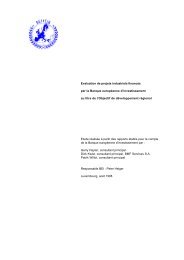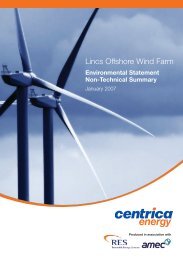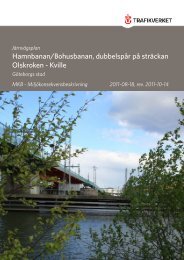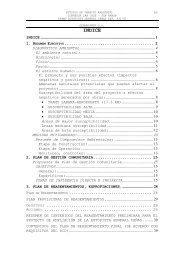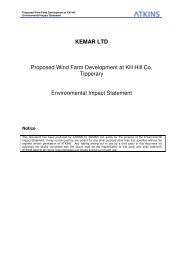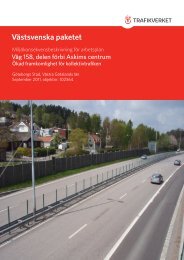Evaluation of Railway Projects in the European Union
Evaluation of Railway Projects in the European Union
Evaluation of Railway Projects in the European Union
You also want an ePaper? Increase the reach of your titles
YUMPU automatically turns print PDFs into web optimized ePapers that Google loves.
Rail Share <strong>of</strong> EU Transport Market 1970-200035% Goods% PassengerRail share <strong>of</strong> transport market3025Market share20151050197019711972197319741975197619771978197919801981198219831984198519861987198819891990199119921993199419951996199719981999Source: “A Strategy for Revitaliz<strong>in</strong>g <strong>the</strong> <strong>Railway</strong>s”, EU Commission (White Paper)Many studies have been carried out to identify <strong>the</strong> causes <strong>of</strong> <strong>the</strong> relative decl<strong>in</strong>e <strong>of</strong> <strong>the</strong> railways and<strong>the</strong>re is more or less a consensus op<strong>in</strong>ion that <strong>the</strong>re are a number <strong>of</strong> exogenous and endogenous(railway-related) causes.• The growth <strong>in</strong> <strong>the</strong> transport <strong>of</strong> f<strong>in</strong>ished and semi-f<strong>in</strong>ished goods, along with <strong>the</strong> decl<strong>in</strong>e <strong>in</strong> <strong>the</strong>transport <strong>of</strong> bulk commodities and raw materials, has benefited modes <strong>of</strong> transport withcomparative transport cost and quality advantages such as road and air transport more than rail.These trends were complemented by <strong>the</strong> grow<strong>in</strong>g specialization <strong>of</strong> <strong>the</strong> transport sector itself tomeet specific customer needs requir<strong>in</strong>g <strong>in</strong>tegrated logistic cha<strong>in</strong>s and just-<strong>in</strong>-time delivery. Forexample, rail is usually at a competitive disadvantage <strong>in</strong> door-to-door services <strong>in</strong> modern<strong>in</strong>tegrated transport cha<strong>in</strong>s that require reliable, on-time and cost-competitive door-to-doordelivery <strong>of</strong> high-value goods <strong>in</strong> vary<strong>in</strong>g quantities. In passenger transport <strong>the</strong> flexibility, comfortand convenience <strong>of</strong> <strong>the</strong> private car can hardly be matched by rail. Similarly, rail has lost out to airtransport <strong>in</strong> <strong>the</strong> boom <strong>in</strong> tourism travel and, more recently, with <strong>the</strong> rise <strong>of</strong> low-cost airl<strong>in</strong>es.• It is also claimed that rail is at a competitive disadvantage vis-à-vis road and air transport onaccount <strong>of</strong> fiscal and transport policy distortions. Thus, road and air are said to be favoured bypolicies that fail to charge properly for <strong>the</strong> use <strong>of</strong> <strong>the</strong>ir <strong>in</strong>frastructure and <strong>the</strong> external costs <strong>the</strong>y<strong>in</strong>cur. 9• To survive, <strong>the</strong> majority <strong>of</strong> railways <strong>in</strong> <strong>the</strong> EU are heavily dependent on government support. Ithas been estimated that on average almost 50% <strong>of</strong> rail <strong>in</strong>frastructure and operational expenditureconsists <strong>of</strong> state subsidies. 10 It follows that state <strong>in</strong>tervention <strong>in</strong> <strong>the</strong> railway sector is much moreprevalent than for o<strong>the</strong>r modes <strong>of</strong> transport.While it may be difficult for <strong>the</strong> railways to <strong>in</strong>fluence <strong>the</strong> exogenous factors mentioned above, <strong>the</strong>re ismuch more scope to reduce or even elim<strong>in</strong>ate <strong>the</strong> majority <strong>of</strong> <strong>the</strong> railway-specific factors hamper<strong>in</strong>gcompetitiveness.910It should be po<strong>in</strong>ted out <strong>in</strong> this context, however, that rail <strong>in</strong>frastructure is heavily subsidized by <strong>the</strong>State as well.With a wide variation between national railways. For <strong>in</strong>stance <strong>in</strong> France and Spa<strong>in</strong>, <strong>the</strong> subsidization <strong>of</strong>regional rail operations is estimated at 70%.9










